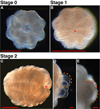A staging system for the regeneration of a polyp from the aboral physa of the anthozoan Cnidarian Nematostella vectensis
- PMID: 23913838
- PMCID: PMC6889817
- DOI: 10.1002/dvdy.24021
A staging system for the regeneration of a polyp from the aboral physa of the anthozoan Cnidarian Nematostella vectensis
Abstract
Background: As the sea anemone Nematostella vectensis emerges as a model for studying regeneration, new tools will be needed to assess its regenerative processes and describe perturbations resulting from experimental investigation. Chief among these is the need for a universal set of staging criteria to establish morphological landmarks that will provide a common format for discussion among investigators.
Results: We have established morphological criteria to describe stages for rapidly assessing regeneration of the aboral end (physa) of Nematostella. Using this staging system, we observed rates of regeneration that are temperature independent during wound healing and temperature dependent afterward. Treatment with 25 μM lipoic acid delays the progression through wound healing without significantly affecting the subsequent rate of regeneration. Also, while an 11-day starvation before amputation causes only a minimal delay in regeneration, this delay is exacerbated by lipoic acid treatment.
Conclusions: A system for staging the progression of regeneration in amputated Nematostella physa based on easily discernible morphological features provides a standard for the field. This system has allowed us to identify both temperature-dependent and -independent phases of regeneration, as well as a nutritional requirement for normal regenerative progression that is exacerbated by lipoic acid.
Keywords: Anthozoa; Cnidarian; Nematostella; lipoic acid; regeneration; staging system.
Copyright © 2013 Wiley Periodicals, Inc.
Figures







References
-
- Agata K, Saito Y, Nakajima E. Unifying principles of regeneration I: Epimorphosis versus morphallaxis. Develop. Growth Differ. 2007;49:73–78. - PubMed
-
- Agata K, Tanaka T, Kobayashi C, Kato K, Saitoh Y. Intercalary Regeneration in Planarians. Developmental Dynamics. 2003;226:308–316. - PubMed
-
- Ball EE, Hayward DC, Saint R, Miller DJ. A simple plan - cnidarians and the origins of developmental mechanisms. Nature Reviews Genetics. 2004;5:567–577. - PubMed
-
- Bossert P, Galliot B. How to use Hydra as a model system to teach biology in the classroom. International Journal of Developmental Biology. 2012;56:637–652. - PubMed
-
- Brøndsted A, Brøndsted HV. Influence of Temperature on Rate of Regeneration in the Time-graded Regeneration Field in Planarians. Journal of Embryology and Experimental Morphology. 1961;9:159–166.
Publication types
MeSH terms
Grants and funding
LinkOut - more resources
Full Text Sources
Other Literature Sources
Research Materials

